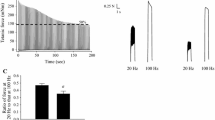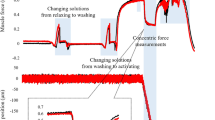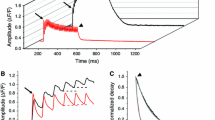Abstract
The biological mechanisms underlying decline in muscle power and fatigue with age are not completely understood. The contribution of alterations in the excitation-calcium release coupling in single muscle fibers was explored in this work. Single muscle fibers were voltage-clamped using the double Vaseline gap technique. The samples were obtained by needle biopsy of the vastus lateralis (quadriceps) from 9 young (25–35 years; 25.9 ± 9.1; 5 female and 4 male) and 11 old subjects (65–75 years; 70.5 ± 2.3; 6 f, 5 m). Data were obtained from 36 and 39 fibers from young and old subjects, respectively. Subjects included in this study had similar physical activity. Denervated and slow-twitch muscle fibers were excluded from this study. A significant reduction of maximum charge movement (Qmax) and DHP-sensitive Ca current were recorded in muscle fibers from the 65–75 group. Qmax values were 7.6 ± 0.9 and 3.2 ± 0.3 nC/μF for young and old muscle fibers, respectively (P < 0.01). No evidences of charge inactivation or interconversion (charge 1 to charge 2) were found. The peak Ca current was (−)4.7 ± 0.08 and (−)2.15 ± 0.11 μA/μF for young and old fibers, respectively (P < 0.01). The peak calcium transient studied with mag-fura-2 (400 μm) was 6.3 ± 0.4 μm and 4.2 ± 0.3 μm for young and old muscle fibers, respectively. Caffeine (0.5 mm) induced potentiation of the peak calcium transient in both groups. The decrease in the voltage-/ Ca-dependent Ca release ratio in old fibers (0.18 ± 0.02) compared to young fibers (0.47 ± 0.03) (P < 0.01), was recorded in the absence of sarcoplasmic reticulum calcium depletion. These data support a significant reduction of the amount of Ca available for triggering mechanical responses in aged skeletal muscle and, the reduction of Ca release is due to DHPR-ryanodine receptor uncoupling in fast-twitch fibers. These alterations can account, at least partially for the skeletal muscle function impairment associated with aging.
Similar content being viewed by others
References
Anderson, K., Cohn, A.H., Meissner, G. 1994. High-affinity [3H]PN200–110 and [3H]Ryanodine binding to rabbit and frog skeletal muscle. Am. J. Physiol. 266:C462-C466
Bergström, J. 1962. Muscle electrolytes in man. Scand. J. Clin. Invest. Suppl. 68:1–110
Booth, F.W., Weeden, S., Tseng, H. 1993. Effect of aging on human skeletal muscle and motor function. Med. Sci. Sports Ex. 26(5):556–560
Brooks, S.V., Faulkner, J.A. 1988. Contractile properties of skeletal muscles from young, adult and aged mice. J. Physiol. 404:71–82
Brooks, S.V., Faulkner, J.A. 1991. Maximum and sustained power of extensor digitorum longus muscles from young, adult and old mice. J. Gerontol. 46:B28–33
Brooks, S.V., Faulkner, J.A. 1993a. Injury to skeletal muscle fibers during contractions: conditions of occurrence and prevention. Phys. Ther. 73:911–921
Brooks, S.V., Faulkner, J.A. 1993b. Skeletal muscle weakness in old age: underlying mechanisms. Med. Sci. Sports Ex. 26(4):432–439
Brooks, S.V., Faulkner, J.A. 1994a. Skeletal muscle weakness in old age: underlying mechanisms. Med. Sci. Sports Exerc. 26:432
Brooks, S.V., Faulkner, J.A. 1994b. Isometric, shortening, and lengthening contractions of muscle fiber segments from adult and old mice. Am. J. Physiol. 267:C507-C513
Brum, G., Ríos, E., Stefani, E. 1988. Effects of extracellular calcium on the calcium movements of excitation contraction coupling in skeletal muscle fibers. J. Physiol. 398:441–473
Campbell, M.J., McComas, A.J., Petito, F. 1973. Physiological changes in ageing muscles. J. Neurol. Neurosurg. Psychiatry 36:74–182
Caputo, C., Bolaños, P. 1989. Effect of D-600 on intramembrane charge movement of polarized and depolarized frog muscle fibers. J. Gen. Physiol. 94:43–64
Carlson, B.M., Faulkner, J.A. 1988. Reinnervation of long-term denervated rat muscle freely grafted into an innervated limb. Exp. Neurol. Exp. Neurol. 102:50
Caroni, P., Schneider, C. 1994. Signaling by insulin-like growth factors in paralyzed skeletal muscle: rapid induction of IGF1 expression in muscle fibers and prevention of interstitial cell proliferation by IGF-BP5 and IGF-BP4. J. Neurosci. 14(5):3378–3388
Cavalié, A., Berninger, B., Haas, C.A., Garcia, D.E., Lindholm, D., Lux, H.D. 1994. Constitative upregulation of calcium channel currents in rat phaeochromocytoma cells: role of c-fos and c-jun. J. Physiol. 479:11–27
Coggan, A.R., Spina, R.J., King, D.S., Rogers, M.A., Brown Nemeth, P.M., Holloszy, J.O. 1992. Histochemical and enzymatic comparison of the gastrocnemius muscle of young and elderly men and women. J. Gerontol. 47:B71-B76
De Coster, W., De Reuck, J., Sieben, G., Vander Eecken, H. 1981. Early ultrastructural changes in aging rat gastrocnemius muscle: a stereologic study. Muscle Nerve 4:111–116
Delbono, O. 1992. Calcium current activation and charge movement in denervated mammalian skeletal muscle fibres. J. Physiol. 451:187–203
Delbono, O. 1995. Ca2+ modulation of sarcoplasmic reticulum Ca2+ release in mammalian skeletal muscle fibers. J. Membrane Biol. 146:91–99
Delbono, O., Chu, A. 1995. Ca2+ release channels in denervated skeletal muscles. Exp. Physiol 80:561–574
Delbono, O., García, J., Appel, S.H., Stefani, E. 1991. Calcium current and charge movement of mammalian muscle: Action of Amyotrophic Lateral Sclerosis immunoglobulins. J. Physiol. 444:723–742
Delbono, O., Stefani, E. 1993a. Calcium current inactivation in denervated mammalian skeletal muscle fibres. J. Physiol. 460:173–183
Delbono, O., Stefani, E. 1993b. Calcium transients in mammalian skeletal muscle fibers. J. Physiol. 463:689–707
Dulhunty, A.F., Gage, P.W. 1983. Asymmetrical charge movement in slow- and fast-twitch mammalian muscle fibres in normal and paraplegic rats. J. Physiol. 341:213–231
Dulhunty, A.F., Gage, P.W. 1985. Excitation-contraction coupling and charge movement in denervated rat extensor digitorum longus and soleus muscles. J. Physiol. 358:75–89
Edstrom, L., Larsson, L. 1987. Effects of age on contractile and enzyme-histochemical properties of fast- and slow-twitch single motor units in the rat. J. Physiol 392:129–145
Engel, A., Stonnington, H.H. 1974. Morphological effects of denervation of muscle. Ann. NY Acad. Sci. 228:68–88
Fabiato, A. 1983. Calcium-induced release of calcium from the cardiac sarcoplasmic reticulum. Am. J. Physiol. 245:C1-C14
Fitts, R.H., Troup, J.P., Witzmann, F.A., Holloszy, J.O. 1984. The effect of ageing and exercise on skeletal muscle function. Mech. Ageing Dev. 27:161–172
Francini, F., Stefani, E. 1989. Decay of the slow calcium current in twitch muscle fibers of the frog is influenced by intracellular EGTA. J. Gen. Physiol. 94:953–969
Fujisawa, K. 1975. Some observations on the skeletal musculature of aged rats. Part 2. Fine morphology of diseased muscle fibres. J. Neurol. Sci. 24:447–469
García, J., McKinley, K., Appel, S.H., Stefani, E. 1992. Ca2+ current and charge movement in adult single human skeletal muscle fibres. J. Physiol. 454:183–196
García, J., Schneider, M.F. 1993. Calcium transients and calcium release in rat fast-twitch skeletal muscle fibres. J. Physiol. 463:709–728
Gibson, G.E., Petersen, Ch. 1987. Calcium and the Aging nervous system. Neurobiol. Aging 8:329–343
González, A., Ríos, E. 1993. Perchlorate enhances transmission in skeletal muscle excitation-contraction coupling. J. Gen. Physiol. 102:373–421
Grynkiewicz, G., Poenie, M., Tsien, R.Y. 1985. A new generation of calcium indicators with greatly improved fluorescent properties. J. Biol. Chem. 260:3440–3450
Gutmann, E., Carlson, B.M. 1976. Regeneration and transplantation of muscles in old rats and between young and old rats. Life Sci. 18:109–114
Hamilton, S.L., Mejía Alvarez, R., Fill, M., Hawkes, M.J., Brush, K.L., Schilling, W.P., Stefani, E. 1989. [3H]PN200–110 and [3H]Ryanodine binding and reconstitution of ion channel activity with skeletal muscle membranes. Anal. Biochem. 183:31–41
Heizmann, C.W. 1984. Parvalbumin, an intracellular calcium-binding protein: distribution, properties and possible roles in mammalian cells. Experientia 40:910–921
Hodgkin, A., Nakajima, S. 1972. The effect of diameter on the electrical constants of frog skeletal muscle fibres. J. Physiol. 221:105–120
Jacquemond, V., Kao, J.P.Y., Schneider, M.F. 1991. Voltage-gated and calcium-gated release during depolarization of skeletal muscle fibres. Biophys. J. 60:867–873
Johnson, M.A., Polgar, J., Weightman, D., Appleton, D. 1973. Data on the distribution of fibre types in thirty-six human muscles. An autopsy study. J. Neurol. Sci. 18(1):111–129
Kanda, K., Hashizume, H. 1989. Changes in properties of the medial gastrocnemius motor units in aging. J. Neurophysiol. 61:737–746
Klein, M.G., Simon, B.J., Schneider, M.F. 1990. Effects of caffeine release from the sarcoplasmic reticulum in frog skeletal muscle fibres. J. Physiol. 425:599–626
Kotsias, B.A., Muchnik, S. 1987. Mechanical and electrical properties of denervated rat skeletal muscles. Exp. Neurol. 97:516–528
Kotsias, B.A., Muchnik, S., Obejero Paz, C.A. 1986. Co2+, low Ca2+, and verapamil reduce mechanical activity in rat skeletal muscles. Am. J. Physiol. 250:C40–46
Kostyuk, P., Pronchuk, N., Savchenko, A., Verkhratsky, A. 1993. Calcium currents in aged rat dorsal root ganglion neurones. J. Physiol. 461:467–483
Landfield, P.W. 1987. “Increased calcium-current” hypothesis of brain aging. Neurobiol. Aging 8:346–347
Larsson, L., Edström, L. 1986. Effect of age on enzyme-hystochemical fibre spectra and contractile properties of fast- and slow-twitch skeletal muscles in the rat. J. Neurol. Sci. 76:69–89
Larsson, L., Salviati, G. 1992. A technique for studies of the contractile apparatus in single human muscle fibre segments obtained by percutaneous biopsy. Acta Physiol. Scand. 146:485–495
Lexell, J., Henriksson-Larsen, K.B., Winglad, B., Sjostrom, M. 1983. Distribution of different fiber types in human skeletal muscles: effects of aging studied in whole muscle cross sections. Muscle and Nerve 6(8):588–595
Ma, J., Gutierrez, L.M., Hosey, M.M., Hosey, E. 1992. Dihidropyridine-sensitive skeletal muscle Ca channels in polarized planar bilayers. 3. Effects of phosphorylation by protein kinase C. Biophys. J. 63:639–647
Melzer, W., Ríos, E., Schneider, M.F. 1986. The removal of myoplasmic free calcium following calcium release in frog skeletal muscle. J. Physiol. 372:261–292
Melzer, W., Ríos, E., Schneider, M.F. 1987. A general procedure for determining calcium release in skeletal muscle fibers. Biophys. J. 51:849–863
Obejero Paz, C.A., Delbono, O., Muchnik, S. 1986. Effects of actinomycin D on contractile properties of denervated rat skeletal muscle. Exp. Neurol 94:509–518
O'Rourke, K.S., Blaivas, M., Ike, R.W. 1994. Utility of needle biopsy in a university rheumatology practice. J. Rheumatol. 21:413–424
Phillips, S.K., Bruce, S.A., Woledge, R.C. 1991. In mice, the muscle weakness due to age is absent during stretching. J. Physiol. 437:63–70
Phillips, S.K., Wiseman, R.W., Woledge, R.C., Kishmerick, M.J. 1993. Neither changes in phosphorus metabolite levels nor myosin isoforms can explain the weakness in aged mouse muscle. J. Physiol. 463:157–167
Pitler, T.A., Landfield, P.W. 1990. Aging-related prolongation of calcium spike duration in rat hippocampal slice neurons. Brain Res. 508:1–6
Reynolds, J.N., and P.L. Carlen 1989. Diminished calcium currents in aged hippocampal dentate gyrus granule neurones. Brain Res. 479:384–390
Saltin, B., Gollnick, P.D. 1983. Skeletal muscle adaptability: significance for metabolism and performance. In: Handbook of Physiology. Skeletal Muscle. American Physiological Society, editor, p. 572. Bethesda, Maryland
Sculptoreanu, A., Scheuer, T., Catterall, W.A. 1993. Voltage-dependent potentiation of L-type Ca2+ channels due to phosphorylation by cAMP-dependent protein kinase. Science 364:240–243
Smith, D.O. 1984. Acetylcholine storage, release and leakage at the neuromuscular junction of mature and aged rats. J. Physiol. 347:161–231
Tanabe, T., Beam, K.G., Powell, J.A., Numa, S. 1988. Restoration of excitation-contraction coupling and slow calcium current in dysgenic muscle by dihydropyridine receptor complementary DNA. Nature 336:134–139
Tanabe, T., Takeshima, H., Mikami, A., Flockerzi, V., Takahashi, H., Kangawa, K., Kojima, H., Matsuo, Hirose, T., Numa, S. 1987. Primary structure of the receptor for calcium channel blockers from skeletal muscle. Nature 328:313–318
Thibault, O., Porter, N.M., Landfield, P.W. 1993. Low Ba2+ and Ca2+ induce a sustained high probability of repolarization openings of L-type Ca2+ channels in hippocampal neurons: physiological implications. Proc. Natl. Acad. Sci. USA 90:11792–11796
Author information
Authors and Affiliations
Additional information
This work was supported by Grant-in-Aid from the American Heart Association (National) and Muscular Dystrophy Association, and National Institutes of Health (2-P60AG18484-06)
Rights and permissions
About this article
Cite this article
Delbono, O., O'Rourke, K.S. & Ettinger, W.H. Excitation-calcium release uncoupling in aged single human skeletal muscle fibers. J. Membarin Biol. 148, 211–222 (1995). https://doi.org/10.1007/BF00235039
Received:
Revised:
Issue Date:
DOI: https://doi.org/10.1007/BF00235039




